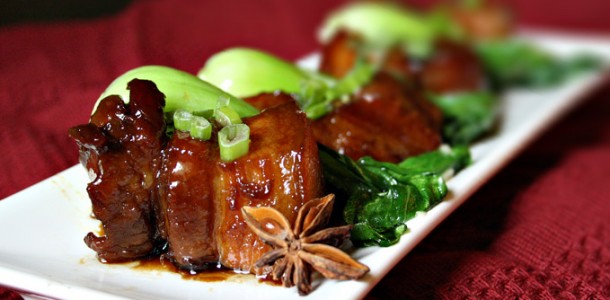- 1 pound pork belly cut into one-inch cubes
- 2 tablespoons peanut oil
- 3 tablespoons brown sugar
- 3 tablespoon dry saki rice wine
- 2 inch piece fresh ginger, unpeeled and sliced
- 1 star anise (count 8 robust points)
- 1 dried red arbol chile
- 2-inch piece Vietnamese cinnamon bark or 1/2 teaspoon ground Vietnamese cinnamon
- 3 green onions, white and green parts, cut into 2-inch lengths
- 2 tablespoons dark soy sauce
- 1 tablespoon light (regular) soy sauce
Red braised pork belly is arguably one of the most unctuous meats you will ever taste. If you’re not familiar with the word unctuous, it has several definitions, but in the context of food it’s used to describe something rich, luxurious, sumptuous and almost spiritual.
The technique used in this recipe originates from the Hunan region of China. Called hong shao, or red cooking, it is a particular favorite of mine; you’ll never taste meat so luscious or sauce with such concentrated flavor. But after one bite, it will become clear that something else is at work here, something that Americans are just beginning to experience. In fact, the main “deliciousness” energizing your taste buds is umami, the fifth taste.
In addition of salt, sweet, sour and bitter, umami is the taste of savory-ness. This fifth element of taste derives from the palate’s ability to detect a particular amino acid, specifically glutamate, if it is unbound to other amino acids. The ability to taste umami may have an evolutionary role reflecting our need for glutamate and other essential amino acids, the building blocks of proteins that we are unable to create on our own and must therefore consume. But whatever its origins, one thing is for sure, red braised pork belly reveals umami’s existence like no other food.
Red braised pork belly is made with ordinary pork belly, which is just unsmoked bacon. Your local butcher should be able to supply you with this cut of meat. When you purchase your pork belly, don’t be afraid to give it a once over before your butcher wraps it up. You don’t want to end up with a piece of pork belly that is mostly fat. Look for the same good layering that you look for in bacon.
Don’t be confused by the term light-soy sauce. This is the regular soy-sauce with which American have become so familiar and not the low-sodium varieties that have recently begun appearing on store shelves. Dark soy sauce is an altogether different creature. Aged for a longer period of time and with molasses or caramel and a bit of cornstarch added, dark soy sauce is thicker and darker in color than light soy sauce, with a more full-bodied flavor. This recipe calls for both.
This recipe also calls for Vietnamese cinnamon. Regular cinnamon can be substituted but most mega-marts and specialty stores carry Vietnamese cinnamon. Vietnamese cinnamon is regarded by many as the world’s most aromatic cinnamon and it has the highest concentration of essential oils than any cinnamon currently found in the world today. Because of the powerful amount of aromatic oils, Vietnamese cinnamon is extremely intense and concentrated with sweet cinnamon flavor. Unlike other cinnamon, Vietnamese cinnamon is surprisingly sweet and robustly spicy. Once you’ve gone Vietnamese, you’ll never go back.
Directions:
- Bring a 3 or 4-quart heavy saucepan of water to a rolling boil drop the pork belly pieces in for 3 to 4 minutes. Transfer the pork to a plate and allow to cool. Discard the cooking liquid and clean the saucepan. We’ll be using it throughout.
- Put the oil and sugar into the saucepan that you just used and heat over medium heat stirring until all the sugar crystals are melted.
- Add the pork and all other ingredients adding just enough water to cover the pork, reserving 1/3 of the green onions.
- Bring to a boil, cover and lower the heat to a simmer for 45 minutes.
- Uncover and continue to cook for 2 more hours, adding water as needed to just keep the pork belly pieces covered.
- During the last 15 to 20 minutes, increase heat to medium reducing the sauce to roughly half its volume.
- Using metal tongs, remove the pork belly from the saucepan leaving the aromatics behind. Place the pork belly on a serving platter dressing the top with the remaining green onions.
To serve, simply place several pieces of pork belly atop steaming jasmine rice.





